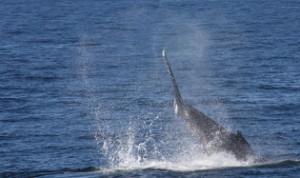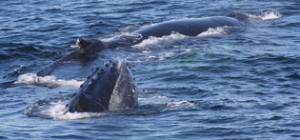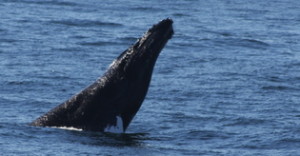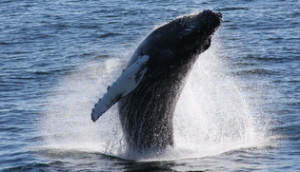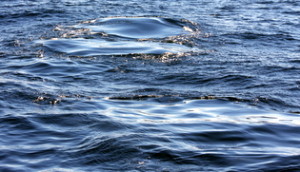Dolphin Fleet Naturalist Notebook 11 October to 17 October
October 11th’s 10am trip was a bit more unusual and exciting than other trips. After spending over an hour with three humpbacks and one Minke whale on the eastern side of Stellwagen Bank, we started to head for home, when suddenly we spotted a buoy moving along the surface rapidly. We soon realized that it was a small humpback whale dragging fishing gear behind it. We immediately called the Large Whale Disentanglement Team at the Provincetown Center for Coastal Studies on their 24 hour hotline. This team of scientists is equipped with gear, training, and permits which allow them to approach whales who have become entangled in fishing gear and attempt to cut them free. This is usually done by throwing hooks and blades at the line while in a zodiac or a small boat.
Entanglement in fishing gear can be a serious problems for whales, as it can inhibit their abilities to eat and breathe. Infections from the rope cutting into the whale’s body can occur which in some cases can be lethal. Entanglements are also thought to affect the whales’ ability to successfully reproduce.
The humpback identified today is a young whale, the 2008 calf of Trident and it has been entangled for several months. Although the disentanglement team arrived on scene shortly after being called, they were unable to disentangle this whale due to its evasive behavior. We are hoping that in the next few weeks, another boat will spot this little whale and the team can try again.
By October 12th, more groups of humpbacks had congregated just south of the Triangle. One group of six, including Circuit and the calf, Barb, Rocker and Crystal, as well as one unknown, were particularly active, with several of them lobtailing and flipper slapping.
Humpback whale groups are very fluid, meaning that they can change over short periods of time. There are no strict “pods” as far as we can tell. Scientists have observed that flipper slapping tends to precede or follow a shift in group dynamics. Sure enough, soon after this display, we noticed that Circuit and her calf had left the group and gone off on their own.
Later in the day, our naturalist recorded that the observed humpbacks were engaging in probable subsurface lunges. This means that the food resource is concentrated lower in the water column, rather than at the surface, and that that is where the whales are feeding. This can be hard behavior to confirm, but sometimes we can tell when a whale rapidly bursts to the surface with expanded ventral pleats…literally coming up with its mouth full!
October 13th was bright and sunny and on our afternoon trip we were lucky enough to spend over fifteen minutes with a breaching humpback. In a group of three unidentified individuals, one whale was causing quite a ruckus by breaching chin breaching, and flipper slapping.
Whales are thought to breach for a variety of reasons, including mating displays, grooming, digestions, social cues, or just plain fun. No one knows for sure! Humpbacks also perform different types of breaches. This whale was doing a combination of chin breaches as well as the full spinning head breach!
October 14th was another gorgeous day with sightings of 17-18 humpback whales. One major highlight of the afternoon trip was a sighting of Salt and Crystal traveling together. This was exciting and somewhat unusual as Salt gave birth to Crystal 30 years ago! Humpback whales exhibit “site fidelity” meaning that they tend to come back to the same feeding ground that their mothers brought them to during their first year of life. Salt has a high affinity for southern Stellwagen Bank, so the presence of Salt and Crystal together in the area is not a huge surprise. However, humpback whales do not typically exhibit familial associations lasting more than the year that moms and calves spend with one another, which is why it was such a treat to see this “family” together. Associations between humpbacks tend to be short, and its likely that they will not travel together for long, but we felt privileged to be able to watch their visit!
Windy weather persisted for the rest of the week, but we will be whale watching until the last week in October, so keep watching for updates!






